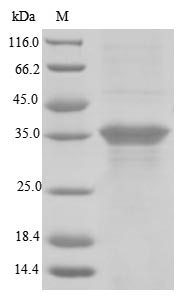The N-terminal 6xHis-GST tag was fused to the gene fragment corresponding to the 388-417aa of the human RHD protein and then was cloned into an expression vector. The expression vector was transformed into the E.coli for expression. The generated product was purified and separated to obtain the recombinant human RHD protein. Its purity is higher than 85%. It showed an apparent molecular weight of about 34 kDa under SDS-PAGE condition.This recombinant human RHD protein may be used in cardiovascular research.
RHD is a gene encoding a protein named blood group Rh(D) polypeptide and belongs Rh subfamily which consist of RHD, RHCE, RhAG, RhBG, and RhCG. RHD has sequence similarity to others and is restricted to tissues or cell lines expressing erythroid characters. It was proposed that the erythrocyte Rh complex is a heterotrimer of RhAG, RhD, and RhCE protein subunits. Diseases associated with RHD include Hemolytic Disease Of Fetus And Newborn, Rh-Induced and Blood Group, Rh System.






